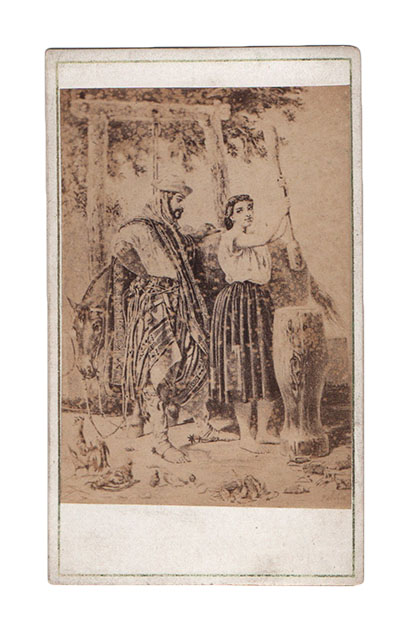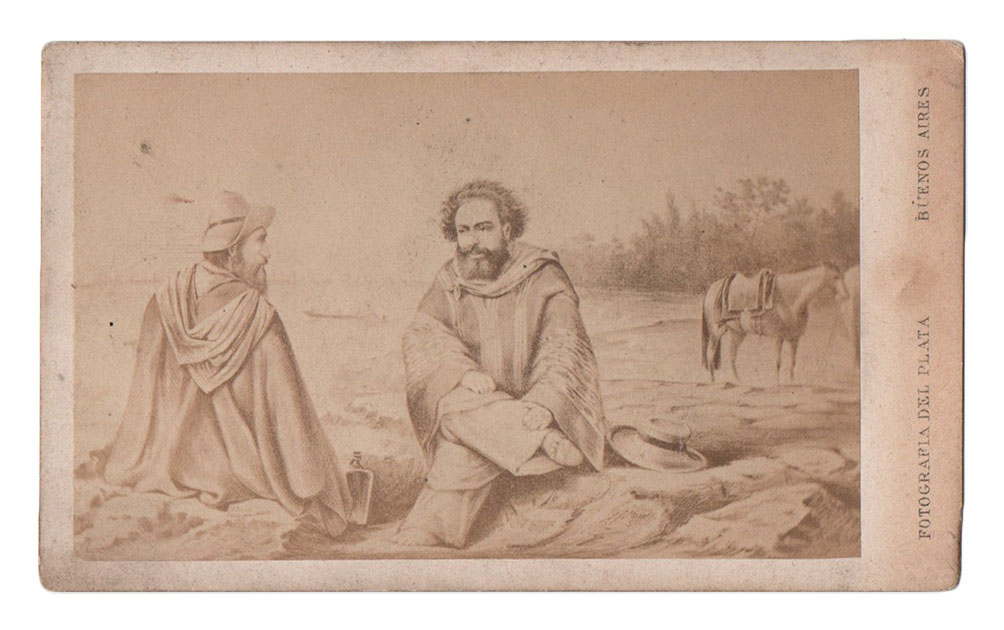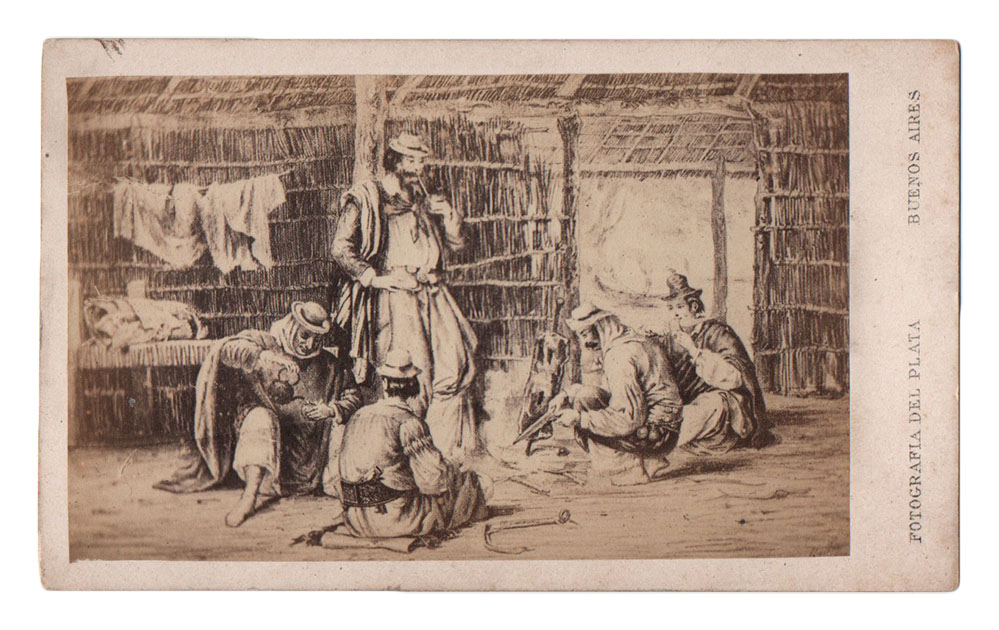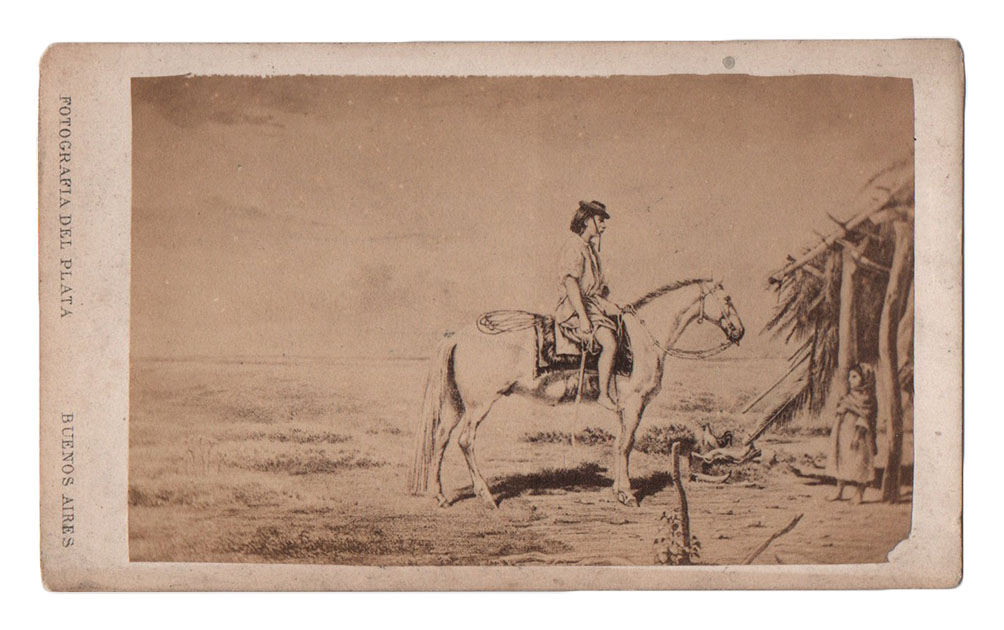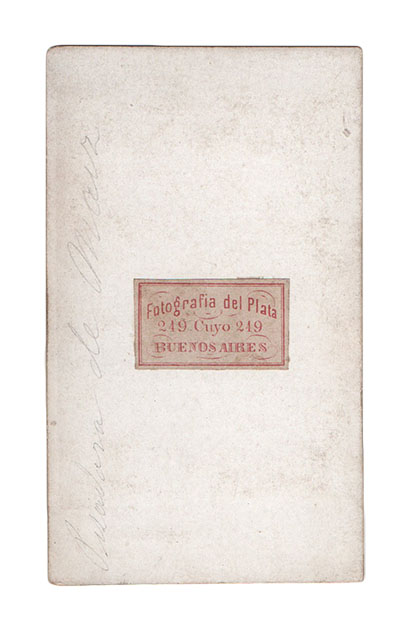WITH THE ENGRAVINGS OF PALLIERE, MEYER AND DULIN
The Argentine rural manners. Buenos Aires. Circa 1866.
Exceptional iconographic set, made up of 21 albums in carte-de-visite format, all in their period cartons, which bear the identification of the photographic house -except for three of them, which it is clear to note that they belong to the same series- by means of ink prints or small rectangular labels affixed to the back of the cartons, with their legend printed in red or black ink indicating "Photograph of the Silver" and their address on Cuyo 249 street in Buenos Aires.
Most of these carte-de-visite, reproduce the lithographs of the Pallière Album. American scenes. Reproduction of paintings, watercolors and sketches, printed in the lithographic workshop of Jules Pelvilain, established in the State of Buenos Aires, which circulated in installments between May 1864 and June or August 1865. That album with its 52 images covered a wide territory , both from the Argentine provinces and from neighboring countries (he had traveled to Chile and Bolivia in 1858, and to Brazil in 1860, in addition to the usual stay in Uruguay). In the set of these carte-de-visite the customs of Buenos Aires and Entre Ríos predominate, with two that refer to the trip to Chile: the stop in San Luis and the crossing through Uspallata. Pallière influenced with his work in the consolidation of rural manners with his almost eleven years of stay, between 1855 and 1866, from developing an iconographic repertoire that implied the “displacement of the descriptive naturalistic representation that had defined the pictorial image of the rural towards a literary model”. (1)
This dynamic reading of costumbrismo allows us to point out a connection with the other carte-de-visite, which reproduce illustrations by Henri Meyer, later director of El Mosquito, for Estanislao del Campo's Fausto, also exiting the Pelvilain lithographic workshop in 1866 and with the photograph dedicated to the print by Jean Desiré Dulin –author of wonderful views of Buenos Aires- representing a Buenos Aires slaughterhouse, which immediately refers us to the famous text by Esteban Echeverría. Dulin remained in Buenos Aires between 1858 and 1864, where he worked closely with Pelvilain (later in Paris he printed at the Lemercier house). Perhaps, this set of carte-de-visite is the result of a commercial agreement between the two companies, Photography del Plata and Pelvilain.
These photographs allow us to understand the development of visual culture in the Río de la Plata in the second half of the 1860s, on the one hand, it is about the reproduction of works already made with a technique that allows multiple copies such as lithography, and that in the case of Pallière they are, at the same time, reproduction of oil paintings, watercolors and drawings prior to the passage to stone, unlike those of Dulin and Meyer, whose drawings were already destined for printing. The existence of these carte-de-visite demonstrates an intense and varied visual demand, probably aimed at both local and foreign audiences: a visual archive of customs from the Río de la Plata, where the pictorial meets the literary. It is worth noting that they are originally lithographs made by French artists in the Río de la Plata, another point of connection to elaborate the corpus to be photographed, in addition to the contemporaneity between the work and its photographic reproduction.
On the reverse, together with the advertising of the photographic house, they have the subsequent manual inscription of the subject that is represented, with variations of the known titles of the lithographs, and without data of the authorship of these. Such absence of information on the "originals" is relevant, it allows us to understand the independent circulation of the photographs in a consumption that was expanding.
Author details and images:
1. Dulin, Jean Desiré (picture) A slaughterhouse in the States of Plata [Gauchos carneando]. The best known impression is that of the Lemercier house in Paris, ca. 1864.
2. Meyer, Henri (dib.), Pelvilain, Jules (lit.). Lithographs for the Faust of Estanislao del Campo, Buenos Aires, 1866.
Splendor. Impressions of the gaucho Anastasio el Pollo in the presentation of this opera [Anastasio el Pollo]
Conversation between Laguna and el Pollo [Two gauchos on the banks of the river]
3. Pallière, Jean Léon (dib.), Pelvilain, Jules (lit.) Album Pallière. American scenes. Reproduction of paintings, watercolors and sketches, Buenos Aires, 1864-1865
El corral (Argentine Republic) [El corral]
Country fruit market (Buenos Aires) [A troop of carts in the pampas]
Cock fight (Argentine Republic) [Cock fight in the field]
Army of General Flores (Paisandú. Eastern-State) [The people of General Flores in the Banda Oriental]
Sunday Walk (Buenos Aires Campaign) [Sunday Walk]
Invasion of Indians [Invasion of Indians]
The payador (Repca. Argentina) [The payador]
Field races (Argentine Republic) [Field races]
Gauchos carneando (Argentine Republic) [Gauchos linking]
Stop for the night (San Luis - Repca. Argentina)
The asado (Repca. Argna) [The asado and the mate]
The Paraná Islands (Tigre - Buenos Aires) [Paraná Islands]
The maize crusher (Argentine Republic) [Maize crusher]
Milkman and baker (Buenos Aires) [Milkman and baker]
La Galera (Repca. Argentina) [A stagecoach in the desert]
Souvenir of Entre-Ríos (Argentine Republic) [A ramada in the field]
Cordillera de los Andes (Pass from Uspallata to Sta. Rosa de Chile) [Descent from Santa Rosa de Lima in the Andes]
Note:
1. Roberto Amigo: Beduinos en la pampa. Apuntes sobre la imagen del gaucho y el orientalismo de los pintores franceses. History and Society Magazine, no. 13, Medellín: National University of Colombia, November 2007, p. 38.
| AUTHOR | FOTOGRAFÍA DEL PLATA |
|---|---|
| ITEM | 44 |
Are you interested in selling some works?
Send us an email briefly indicating
which works you intend to put on sale, and we will respond. click here
Subscribe to our newsletter to be updated.
Check our Newsletters